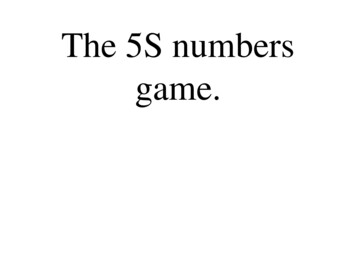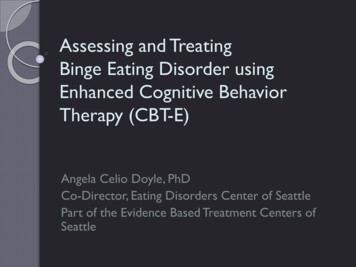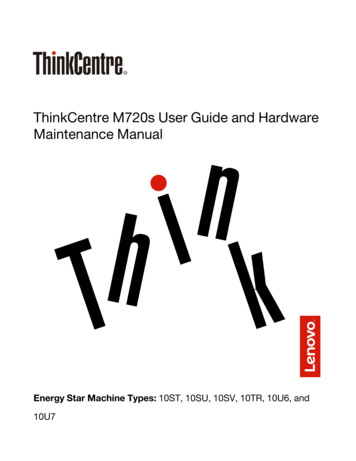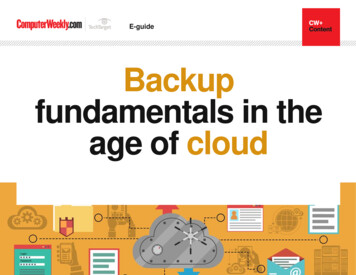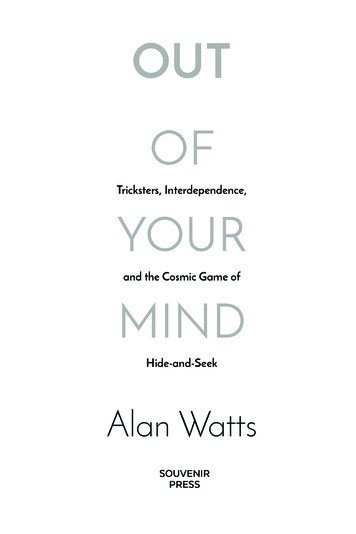
Transcription
OUTOFTricksters, Interdependence,YOURand the Cosmic Game ofMINDHide-and-SeekAlan WattsBOULDER, COLORADO
This paperback published in 2019First published in Great Britain in 2018 by Souvenir Press,an imprint of Profile Books Ltd3 Holford YardBevin WayLondonWC1X 9HDwww.profilebooks.comFirst published in the USA by Sounds True, Boulder, CO 80306Copyright 2017, 2018, 2019 Alan WattsPreface 2017 Mark WattsThe right of Alan Watts to be identified as the author of this work has been asserted inaccordance with section 77 of the Copyright, Designs and Patents Act, 1988All rights reserved. No part of this publication may be reproduced, stored in aretrieval system or transmitted, in any form or by any means, electronic, mechanical,photocopying, or otherwise, without the prior permission of the Copyright owner.Source of Recordings:Alan Watts Electronic UniversityP.O. Box 2309 San Anselmo, CA USA 94979email: watts@alanwatts.comWorld Wide Web: alanwatts.comISBN 978 1 78816 445 0eISBN 978 0 28564 409 0Book design by Beth SkelleyPrinted and bound in Great Britain byCPI Group (UK) Ltd, Croydon, CRO 4YYCert no. TT-COC-002227
ContentsAcknowledgments . . . ixPreface by Mark Watts . . . xiPART ONETHE NATURE OF CONSCIOUSNESSCHAPTER 1Cosmological Models of the World . . . 3CHAPTER 2The Dramatic Model . . . 15CHAPTER 3The Eternal Transaction . . . 27PART TWOTHE WEB OF LIFECHAPTER 4Levels of Perception . . . 39CHAPTER 5The Web as Trap . . . 49CHAPTER 6The Web as Play . . . 55PART THREEINEVITABLE ECSTASYCHAPTER 7Attachment and Control . . . 63CHAPTER 8Hypnosis and Habituation . . . 77CHAPTER 9Harmonious Dissolution . . . 83vii
PART FOURTHE WORLD AS JUST SOCHAPTER 10The Koan of Zen . . . 91CHAPTER 11Nonduality in Action . . . 99CHAPTER 12A Great Doubt . . . 111PART FIVETHE WORLD AS SELFCHAPTER 13Hindu Cosmology . . . 121CHAPTER 14Insiders and Outsiders . . . 135PART SIXTHE WORLD AS EMPTINESSCHAPTER 15The Buddhist Method . . . 153CHAPTER 16Impermanence by Any Name . . . 161CHAPTER 17The Doctrine of Emptiness . . . 169About the Author . . . 177CONTENTS viii
Preface by Mark WattsBack in the midfifties, my father gained a large following forhis public radio talks on station KPFA in Berkeley, California,and these talks were soon followed by the bestselling Way ofZen and his groundbreaking Psychotherapy East and West. His approachresonated well with open-minded Bay Area audiences as he examinedthe wisdoms of Asia through the fresh lenses of Western psychologyand the emerging scientific revelations of the postatomic age. In histalks, he often suggested that Buddhism should be thought of as aform of psychotherapy, and was not to be compared with Westernreligions. Instead, he felt that in essence ecological awareness andmystical experience were expressions of the same form of awakenedexperience. By the early sixties, his radio talks and landmark bookshad nudged him out onto the college speaking circuit, and for the nexttwelve years, he delivered large-hall public lectures and more intimateseminars to groups across the country. Many of these sessions wererecorded and collected.Nearly ten years ago, after reviewing dozens of the seminarsmy father recorded in the late sixties and early seventies, I selectedrecordings — that flowed together beautifully — from six historicevents to become the Out of Your Mind audio collection. They areall exceptional sessions, including “The Nature of Consciousness,”“Web of Life,” “Inevitable Ecstasy,” “The World as Just So,” “TheWorld as Self,” and “The World as Emptiness.”Upon its release, Out of Your Mind was an immediate success,and over the years it became one of the most listened-to Alan Wattsseries of all time, attracting audiences from all over the world.xi
The series of talks began with all-encompassing themes, including core issues of shared perception, comparative cosmology, andhumankind’s place in the natural world. In these talks, my fatherdemonstrated convincingly that most of the common sense of theWestern world is rooted in outdated science and the dominant cultural constructs of the nineteenth century. Always ready to challengethe status quo, he tackled assumptions that many took for granted,demonstrating how out of touch with the contemporary state ofknowledge the “everyday reality” of the Western world had become.As this body of work developed, he also offered solutions, bothpsychological and cosmological, and in drawing increasingly from theBuddhist worldview that he explored in these seminars, he offereda fresh and convincing alternative perspective, one of a universe inwhich we are both inseparable and welcome participants, and at thesame time expressions of the “entire works.” In this ultimately reciprocal worldview, we find not only our place in and of nature, but alsothe tools with which to share this mind-shifting perspective of lifewith others.Even though I understood the power of these talks, I was unprepared for what began to happen as they made their way out and intothe world. In addition to being popular with many of Sounds True’slisteners, the collection began to attract a new, younger audience, andseveral years after its release, quotes and videos began to pop up regularly on social media. Creative video posts based on clips were gettingmillions of views as well (twenty million at last count), and it is by farthe most rewarding aspect of continuing my father’s works to see howthese ideas are received in the lives of many, and to watch as they takeon new forms and continue to grow.PREFACE xii
PART ONETHE NATUREOFCONSCIOUSNESS
1Cosmological Models of the WorldIwant to start by looking at some of the basic ideas that underlieour common sense in the West — our fundamental notions aboutwhat life is all about. There are historical origins for these ideas,and their influence is a lot stronger than most people realize. I’m referring to our essential beliefs about the world — beliefs that are built intoour systems of logic and the very nature of the language we use.I’ll use the word myth to refer to these ideas. Not to denote something untrue, but to call to mind something quite powerful. A mythin this sense is an image we use to make sense of the world, and atpresent, we live under the influence of two extremely powerful images,both of which are entirely inadequate in the present state of scientificknowledge. One of our most important challenges today is to replacethese myths with an adequate, satisfying, and sensible image of theworld that accords with our actual experience of it.So, the two fundamental images of the world that we’ve been operating under for more than two thousand years are essentially modelsof the universe: the ceramic model and the fully automatic model. Let’slook at the first of these, the ceramic model.The ceramic model of the universe originates from the book ofGenesis, from which Judaism, Christianity, and Islam all derive theirbasic picture of the world. And the image of the world that comesfrom the book of Genesis is that the world is an artifact made by the3
Creator — just as a potter forms pots out of clay, or a carpenter fashions tables and chairs from wood. Don’t forget that Jesus, the Son ofGod, is also the son of a carpenter. So, in this way, the image of Godwe have is one of a potter, carpenter, technician, or architect who creates the universe in accordance with his plan.Essential to this first model of the universe is the notion that theworld consists of stuff — primordial matter or substance. And just asthe potter takes clay and imposes his will upon it, so does the Creatorcraft the universe out of this fundamental stuff. He takes it and makesit into whatever he wants. And so in the book of Genesis, the LordGod makes Adam out of dust — he fashions a clay figurine, breathesinto it, and it becomes alive. The clay becomes informed. See, by itself,the clay is formless and comes with no intelligence, so it requires anexternal intelligence — an external energy — to bring it to life and putsome sense in it.This is how we’ve inherited the concept of ourselves as artifacts, asthings that were made. In our culture, children ask their parents, “Howwas I made?” or “Who made me?” But these aren’t questions asked byChinese or Indian (specifically, Hindu) children. Now, a Chinese childmight ask her mother, “How did I grow?” But growing and making areentirely different procedures. You see, when you make something, youput it together — you arrange its parts, you work from the outside tothe in. Again, that’s how a potter works on clay, or a sculptor workson stone. However, when you watch something grow, it happens inthe opposite direction — that is, from the inside to the out. Growthmeans that something expands, burgeons, blossoms, and happens allover itself at once. The original, simple form of a living cell in thewomb will progressively complicate itself.That’s what the growing process looks like, as opposed to the makingprocess. Note that in this model, there’s a fundamental difference betweenthe maker and the made thing, between the Creator and his creature.Where did this idea originate? Basically, the ceramic model of theuniverse came out of cultures with monarchical forms of government.And so, for them, the maker of the universe was also conceived as theOUT OF YOUR MIND 4
king of the universe — “King of kings, Lord of lords, only Ruler ofprinces . . .” — I’m quoting from the Book of Common Prayer here.People who orient themselves to the universe in this way relate to basicreality as a subject relates to a king, and so they’re on very humbleterms with whatever it is that runs the whole show. I find it odd thathere in the United States, citizens of a democracy still hold to such amonarchical theory of the universe.So the idea that we must kneel, bow, and prostrate before the Lordof the universe out of humility and respect is a holdover from ancientNear Eastern cultures. But why? Basically, no one is more frightenedthan a tyrant. That’s why he sits with his back to the wall while you mustapproach him from below with your face to the ground. See, you can’tuse your weapons that way. When you approach the ruler, you don’tstand up and face him, because you might attack him. And very wellyou might, because he rules your life, and the man who rules your lifeis the biggest crook in the bunch. In other words, the ruler is the onewho’s allowed to commit crimes against you; criminals are just peoplewe lock up in jail.So, when you design a church, what does it look like? Althoughthis has changed in some cases, for the longest time the CatholicChurch placed the altar with its back to the wall at the east end ofthe building. The altar is the throne, and the priest is the chief — thevizier of the court — and he makes obeisance to the throne in front.And all the people face the throne and kneel down before it. A greatCatholic cathedral is called a basilica, from the Greek basileus, whichmeans “king.” So a basilica is the house of the king, and the ritual ofthe Catholic Church is based on the court rituals of Byzantium. AProtestant church looks a little different — it resembles a judicial courthouse — but its appearance betrays a belief in the same model of theuniverse. The judge in an American court wears a black robe, as didProtestant ministers, and everyone sits in some kind of box — pulpitsand pews that resemble where the judge and members of the jury sit.These forms of Christianity share an autocratic view of the natureof the universe, so the architecture of their churches reflects that view.COSMOLOGICAL MODELS OF THE WORLD 5
The Catholic version builds everything around the king, whereas theProtestant church is designed around the judge. But when you tryto apply these images to the universe itself — to the very nature oflife — you find them very limiting.To begin with, let’s look at the supposed split between matter andspirit — an idea essential to the ceramic model. What is matter? It’s aquestion that physicists once attempted to explore, because they soughtto understand the fundamental substance of the world, but that question — “What is matter?” — is one they stopped asking long ago. See,in exploring the nature of matter, physicists realized they could onlydescribe it in terms of behavior — in terms of form and pattern. In finding smaller and smaller particles — atoms, electrons, protons, all sorts ofnuclear particles — you never arrive at any fundamental stuff, so you canonly describe how it appears to act.What happens is this: We use the word stuff because that’s how theworld looks when our eyes are out of focus. We think of stuff as if it weresome kind of undifferentiated goo, but that’s merely because our visionis fuzzy. When we focus, we’re able to see forms and patterns, and all wecan really talk about is patterns. The picture of the world offered by themost sophisticated efforts of physics today is not one of formed stuff orpotted clay, but patterns — self-moving, self-designing, dancing patterns.But our common sense hasn’t yet caught up with this new picture.And that brings us to our second operating image of the world — thefully automatic model. As Western thought evolved, the ceramic modelran into trouble. For the longest time, Western science was influencedby Judaism, Christianity, and Islam to assume that particular laws ofnature existed and that these laws were established in the beginning bythe Creator, the maker of the universe. So we have tended to think ofall natural phenomena as obeying certain laws according to plan, likea well-behaved machine — a timely streetcar, train, or tram. Well, inthe eighteenth century, Western intellectuals began to question thisidea, specifically whether or not a prime mover — a universal architect — actually exists. They reasoned that there might be universal laws,but that doesn’t necessitate a creator of those laws.OUT OF YOUR MIND 6
See, the hypothesis of God did little in the way of helping to makepredictions, and that’s the business of science: What’s going to happen?By studying the behavior of the past and describing it carefully, we canmake predictions about what’s going to happen in the future — that’sreally the whole of science. And to do this and to make successful predictions, it turns out that you don’t need God as a hypothesis, becauseit makes no difference to anything. So they dropped the God hypothesis and kept the hypothesis of law, because you can make predictionsfrom behavioral regularities in the universe. They got rid of the lawmaker and kept the law.And this is how we arrived at the current conception of theuniverse as a machine, as something that functions according toclocklike, mechanical principles. Newton’s image of the world isbased on billiards — atoms are like billiard balls that bang each otheraround at predictable angles. And the behavior of every individual,therefore, is viewed as a complex arrangement of billiard balls beingbanged around by everything else. This is the fully automatic modelof the universe. The notion of reality as blind energy. We see this inthe nineteenth- century thought of Ernst Haeckel and T. H. Huxley,who described the world as nothing but unintelligent force, as wellas in the philosophy of Freud, who identified our basic psychologicalenergy as libido — blind lust.So, according to this view, we’re all flukes. Out of the exuberanceof blind energy and the result of pure chance, here we are with allour values, languages, cultures, and love. It’s like the idea that onethousand monkeys banging away at one thousand typewriters for millions of years will eventually write the Encyclopedia Britannica andthen immediately relapse into typing nonsense. But if we subscribe tothis idea and like being alive and human, we end up needing to fightnature at every turn, because nature will turn us back into nonsensethe moment we let it. And so we impose our will upon the world asif it were something completely alien to us — something that existson the outside. That’s why we have a culture based on the idea of warbetween people and nature.COSMOLOGICAL MODELS OF THE WORLD 7
Additionally, in the United States, we define manliness in terms ofaggression. I think it must be because we’re frightened. We put on thisshow of being tough guys, but it’s completely unnecessary, you know.If you have what it takes, you don’t need to put on an act, and youcertainly don’t need to beat nature into submission. Why be hostileto nature?You are not something separate from nature. You are an aspect or asymptom of nature. You, as a human being, grow out of this physicaluniverse in exactly the same way that an apple grows out of an appletree. A tree that grows apples is a tree with apples, just as a universe inwhich human beings appear is a universe of human beings. The existence of people is symptomatic of the kind of universe we live in, butunder the influence of our two great myths — the ceramic and fullyautomatic models of the universe — we feel that we do not belong inthe world. In popular speech, we say, “I came into the world,” but wedidn’t — we came out of the world.Most people have the sensation that they are a something that existsinside a bag of skin. We feel we are a consciousness looking out atthis thing. And then we look at others who resemble us and considerthem as people as long as they have similar skin color or religion orwhat-have-you. Note that when we decide to destroy a particular set ofpeople, we always define them as unpeople — not exactly human. So wecall them monkeys or monsters or machines, but definitely not people.Whatever hostility we carry toward others and the external worldcomes from this superstition, [this myth,] an absolutely unfoundedtheory that we’re something that only exists inside our own skin.I want to propose a different idea. Let’s start with the big bang, thetheory that billions of years ago, there was a primordial explosion thatflung all these galaxies and stars into space. Let’s just say for the sake ofargument that was the way it happened. It’s like someone took a bottleof ink and smashed it against a wall — the ink spread from the bigsplash in the middle, and out on the edges you have all of these finedroplets in complicated patterns. Just like that, there was a big bang atthe beginning of things, and it spread out through space, and you andOUT OF YOUR MIND 8
I are sitting here as complicated human beings way out on the fringesof that initial explosion.If you think that you are something that exists inside your ownskin, you will define yourself as one complicated, tiny curlicue amongothers out on the edge of space. Maybe billions of years ago, you werepart of that big bang, but now you aren’t — you’re something separate.But it’s only because you’ve cut yourself off; it all depends on how youdefine yourself. And here’s my alternative idea: If there was a big bangat the beginning of time, you are not something that is the result ofthat explosion at the end of the process. You are the process.You are the big bang. You are the original force of the universemanifesting as whoever you are in the moment. You define yourselfas Mr. or Mrs. or Ms. So-and-So, but you’re actually the primordialenergy of the universe that’s still in process. It’s just that you learned todefine yourself as something separate.This is one of the basic assumptions that follows from the mythswe’ve been taught to believe. We actually think that separate thingsand separate events exist. I once asked a group of teenagers how theywould define a “thing.” At first they said, “A thing is an object,” butthat’s just a synonym — just a different word for “thing.” But then onesmart girl in the group said, “A thing is a noun,” and she was right. Buta noun isn’t part of nature — it’s a part of speech. Nouns don’t exist inthe physical world, and neither do separate things.See, the physical world is wiggly. Clouds, mountains, trees,people — everything is wiggly. It’s only when human beings get working on things that they build buildings in straight lines and try tomake the world unwiggly. But here we are — sitting in rooms with allthese straight lines — but each one of us is wiggly as all get-out.When you want control over something that wiggles, it’s pretty difficult. A fish is extremely wiggly. When you try to grab a fish, it slipsright out of your grasp; so how do you get a hold of it? You use a net.In the same way, we use nets to hold on to the wiggly world. If youwant to control a wiggle, you’ve got to throw some kind of net overit. That’s our foundation for measuring the world: nets with so manyCOSMOLOGICAL MODELS OF THE WORLD 9
holes across and so many holes up and down to help us determinewhere each wiggle is in terms of the holes in that net. And this is howwe break up wiggles into bits. This part of the wiggle is a thing, thisother part of the wiggle is an event, and we talk about the bits as ifthey were separate things unto themselves. But in nature, wiggles don’tcome “pre-bitted.” That’s just our way of measuring and controllingpatterns and processes. If you want to eat a chicken, you have to cut itup in order to take a bite — it doesn’t come already bitten. In the sameway, the world doesn’t come thinged. It doesn’t arrive already evented.You and I are as continuous with the physical universe as a waveis continuous with the ocean. The ocean waves, the universe peoples.But we have been hypnotized — literally hypnotized — into feeling andsensing that we exist as separate entities inside our own skin. We don’tidentify with the original big bang — we think we are just somethingout on the end of it. So we’re all scared stiff. Because our wave is goingto disappear, and we’re going to die, and that’s going to be just awful.As one priest I know is fond of saying, “We’re nothing. But somethinghappens between the maternity ward and the crematorium.” Andthat’s the mythology we’re operating under. Which is why everyonefeels unhappy and miserable.Some people might claim to be Christians. They might go tochurch, might say they believe in heaven and the afterlife, but theydon’t. They just think they ought to believe in such and such a way.They just believe they should believe in the teachings of Christ, butwhat they really believe in is the fully automatic model. And most ofus believe this way — that we’re some kind of cosmic fluke, that we’rea separate event occurring between the maternity ward and the crematorium, and lights out — that’s it.Why would anyone think this way? There’s no reason to — it isn’teven scientific. It’s just a myth, a story invented by people who wantedto feel a certain way or play a certain game. See, the game of Godbecame embarrassing. We started with the idea of God as a potter orarchitect or creator of the universe, and that was good. It made us feelthat life was important, that we had meaning, that there was a GodOUT OF YOUR MIND 10
who cared. We had a sense of feeling valuable in the eyes of the Father.But after a while, it became embarrassing when we realized that Godcould see everything we felt and did, right down to our innermostthoughts and feelings. So in order to get rid of that feeling, we becameatheists and just started to feel terrible. Because when we got rid ofGod, we got rid of ourselves. We became nothing but machines.As Camus put it in The Myth of Sisyphus, “There is but one truly serious philosophical problem and that is suicide.” And if you believe in thefully automatic model — that you’re some kind of separate consciousness existing by yourself out in the blind mechanism of space — then thequestion of suicide makes a lot of sense. So, whether or not you shouldcommit suicide — that’s a good question. Why go on? You should onlygo on if the game is worth it. The universe has been going on for anincredibly long time, so a satisfactory theory of the universe has to beone worth betting on. That’s just common sense. If you want to go onplaying the game, you need an optimal theory for playing it, otherwiseyou might as well commit suicide, because there’s no point in the game.The people who came up with the fully automatic model were playing a funny, sideways kind of game. They said, “All you people whobelieve in religion are old ladies and wishful thinkers. You want yourbig daddy up there in the sky to comfort you through the hard times,because life is rough and painful. And the only way you can succeedin life is to bite back and get tough. You have to be strong and facefacts. Life is just a bunch of junk, and you have to impose your will onthe world and make it do what you want.” And this was a convenienttheory to come up with when the Europeans were out in the worldcolonizing natives everywhere. It was a way of justifying their actionsand flattering themselves.Even today, if you’re an academic, intelligent person, you’reexpected to believe in the fully automatic model. No other theory ofthe world is considered respectable. So, to be an intellectually rigorousperson, you’re supposed to be prickly.There are basically two kinds of philosophy: prickles and goo. Pricklypeople are precise and logical—they like everything chopped up and clear.COSMOLOGICAL MODELS OF THE WORLD 11
On the other hand, goo people like it vague. In physics, prickly peopleare those who believe that the ultimate constituency of matter is particles,whereas goo people believe in waves. In philosophy, prickly people arelogical positivists, and goo people are idealists. And they’re always arguingwith each other. But neither could take a position without the otherperson, because you wouldn’t know that you advocated prickles unlessthere were someone out there advocating goo. You can’t know a pricklewithout the goo. And life is neither prickles nor goo—it’s gooey pricklesand prickly goo.I’m a philosopher. If you don’t argue with me, I don’t know what tothink. So if we argue, I have to say “thank you,” because owing to thecourtesy of your taking a different point of view, I understand what Ithink and mean. So I can’t get rid of you.But this whole idea that the universe is nothing but unintelligentforce playing around out there and not even enjoying it is an incredibly insulting theory of the world. And the people who made thatgame — the game of putting the world down — thought they were superior because of it. But that just won’t do. If you go along with thattheory of the world, you become alienated, you feel the world is a mechanism, a trap, and you begin to feel hostile toward it. As if it were a coldarrangement of electronic and neurological mechanisms into which yousomehow got caught. And you’re stuck in this body that’s falling apart,poor thing — you get cancer, the great Siberian Itch, and it’s all just terrible. And these mechanic doctors try to help you out, but of course theycan’t succeed in the end — you’re just going to keep falling apart and it’sa grim business and it’s just too bad. So, in this scenario, if you thinkthat’s the way things are, you may as well commit suicide right now.But maybe you think, after all, that there might be eternaldamnation lurking somewhere as a consequence of suicide. Or youthink of your children, how they won’t have anyone to support themif you kill yourself. So you decide to go on. So you go on in the sameframe of mind and teach your children to do the same. And then theygo on and support their children without enjoying their lives, andthey’re afraid to commit suicide too, and so will their children.OUT OF YOUR MIND 12
Alan Watts Electronic University P.O. Box 2309 San Anselmo, CA USA 94979 email: watts@alanwatts.com World Wide Web: alanwatts.com ISBN 978 1 78816 445 0 eISBN 978 0 28564 409 0 Book design by Beth Skelley Printed and bound in Great Britain by CP



